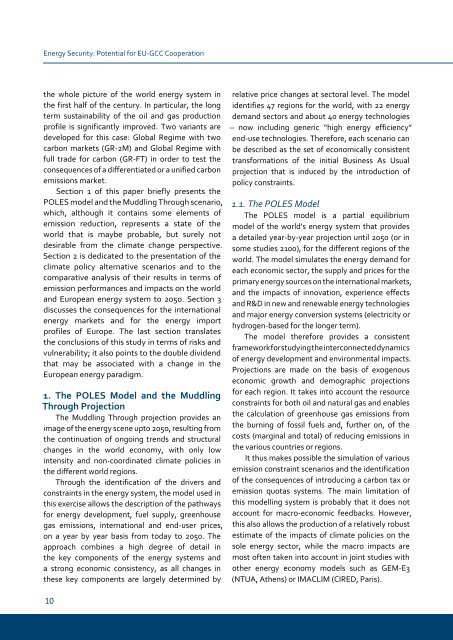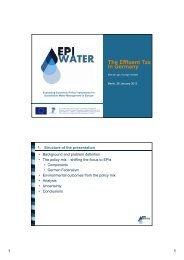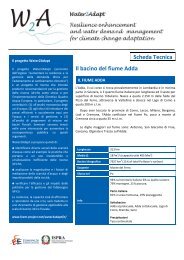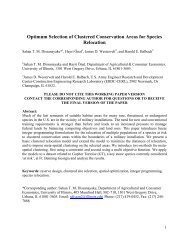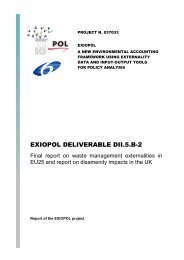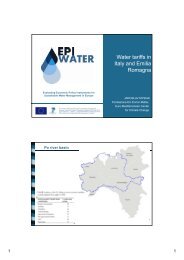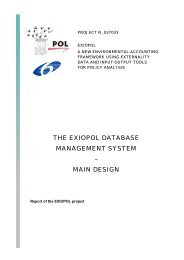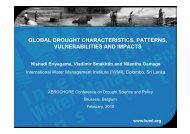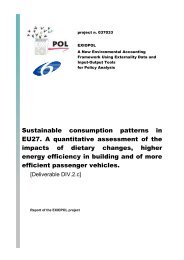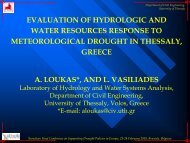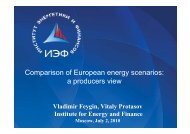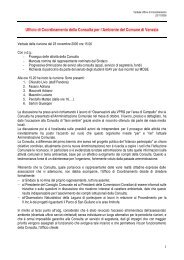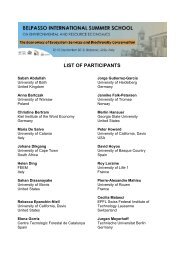Gulf and European Energy Supply Security - Feem-project.net
Gulf and European Energy Supply Security - Feem-project.net
Gulf and European Energy Supply Security - Feem-project.net
Create successful ePaper yourself
Turn your PDF publications into a flip-book with our unique Google optimized e-Paper software.
<strong>Energy</strong> <strong>Security</strong>: Potential for EU-GCC Cooperation<br />
the whole picture of the world energy system in<br />
the first half of the century. In particular, the long<br />
term sustainability of the oil <strong>and</strong> gas production<br />
profile is significantly improved. Two variants are<br />
developed for this case: Global Regime with two<br />
carbon markets (GR-2M) <strong>and</strong> Global Regime with<br />
full trade for carbon (GR-FT) in order to test the<br />
consequences of a differentiated or a unified carbon<br />
emissions market.<br />
Section 1 of this paper briefly presents the<br />
POLES model <strong>and</strong> the Muddling Through scenario,<br />
which, although it contains some elements of<br />
emission reduction, represents a state of the<br />
world that is maybe probable, but surely not<br />
desirable from the climate change perspective.<br />
Section 2 is dedicated to the presentation of the<br />
climate policy alternative scenarios <strong>and</strong> to the<br />
comparative analysis of their results in terms of<br />
emission performances <strong>and</strong> impacts on the world<br />
<strong>and</strong> <strong>European</strong> energy system to 2050. Section 3<br />
discusses the consequences for the international<br />
energy markets <strong>and</strong> for the energy import<br />
profiles of Europe. The last section translates<br />
the conclusions of this study in terms of risks <strong>and</strong><br />
vulnerability; it also points to the double dividend<br />
that may be associated with a change in the<br />
<strong>European</strong> energy paradigm.<br />
1. the PoLes Model <strong>and</strong> the Muddling<br />
through Projection<br />
The Muddling Through <strong>project</strong>ion provides an<br />
image of the energy scene upto 2050, resulting from<br />
the continuation of ongoing trends <strong>and</strong> structural<br />
changes in the world economy, with only low<br />
intensity <strong>and</strong> non-coordinated climate policies in<br />
the different world regions.<br />
Through the identification of the drivers <strong>and</strong><br />
constraints in the energy system, the model used in<br />
this exercise allows the description of the pathways<br />
for energy development, fuel supply, greenhouse<br />
gas emissions, international <strong>and</strong> end-user prices,<br />
on a year by year basis from today to 2050. The<br />
approach combines a high degree of detail in<br />
the key components of the energy systems <strong>and</strong><br />
a strong economic consistency, as all changes in<br />
these key components are largely determined by<br />
10<br />
relative price changes at sectoral level. The model<br />
identifies 47 regions for the world, with 22 energy<br />
dem<strong>and</strong> sectors <strong>and</strong> about 40 energy technologies<br />
– now including generic “high energy efficiency”<br />
end-use technologies. Therefore, each scenario can<br />
be described as the set of economically consistent<br />
transformations of the initial Business As Usual<br />
<strong>project</strong>ion that is induced by the introduction of<br />
policy constraints.<br />
1.1. The POLES Model<br />
The POLES model is a partial equilibrium<br />
model of the world’s energy system that provides<br />
a detailed year-by-year <strong>project</strong>ion until 2050 (or in<br />
some studies 2100), for the different regions of the<br />
world. The model simulates the energy dem<strong>and</strong> for<br />
each economic sector, the supply <strong>and</strong> prices for the<br />
primary energy sources on the international markets,<br />
<strong>and</strong> the impacts of innovation, experience effects<br />
<strong>and</strong> R&D in new <strong>and</strong> renewable energy technologies<br />
<strong>and</strong> major energy conversion systems (electricity or<br />
hydrogen-based for the longer term).<br />
The model therefore provides a consistent<br />
framework for studying the interconnected dynamics<br />
of energy development <strong>and</strong> environmental impacts.<br />
Projections are made on the basis of exogenous<br />
economic growth <strong>and</strong> demographic <strong>project</strong>ions<br />
for each region. It takes into account the resource<br />
constraints for both oil <strong>and</strong> natural gas <strong>and</strong> enables<br />
the calculation of greenhouse gas emissions from<br />
the burning of fossil fuels <strong>and</strong>, further on, of the<br />
costs (marginal <strong>and</strong> total) of reducing emissions in<br />
the various countries or regions.<br />
It thus makes possible the simulation of various<br />
emission constraint scenarios <strong>and</strong> the identification<br />
of the consequences of introducing a carbon tax or<br />
emission quotas systems. The main limitation of<br />
this modelling system is probably that it does not<br />
account for macro-economic feedbacks. However,<br />
this also allows the production of a relatively robust<br />
estimate of the impacts of climate policies on the<br />
sole energy sector, while the macro impacts are<br />
most often taken into account in joint studies with<br />
other energy economy models such as GEM-E3<br />
(NTUA, Athens) or IMACLIM (CIRED, Paris).


